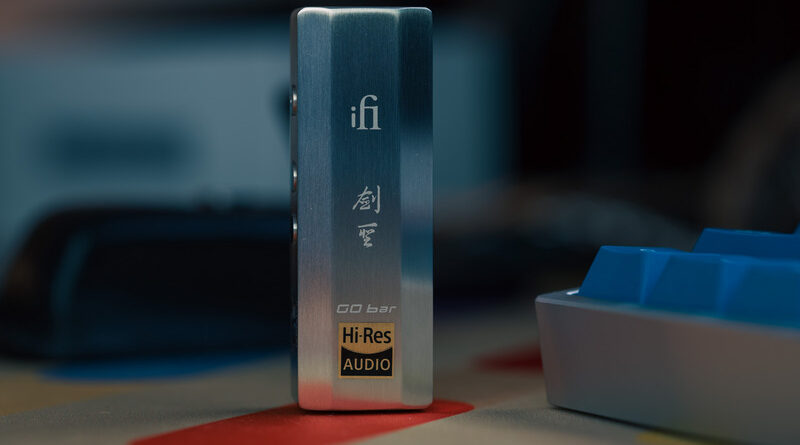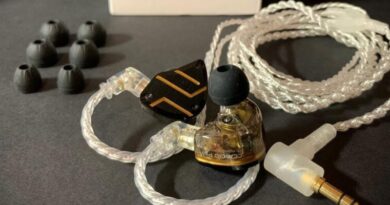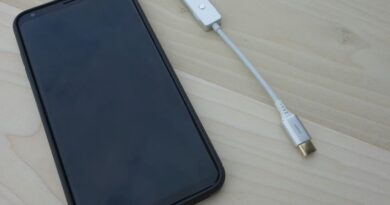iFi Go Bar Kensei Review – Refined Katana
Pros — Class leading build quality
– Excellent pairing with high impedance dynamic driver headphones
– xBass and xSpace offer tasteful coloration
– Good dynamics
Cons — Heavy chassis of the Go Bar Kensei make mobile use cumbersome
– Not suitable for extremely low impedance loads (<8ohm)
– K2HD’s sonic improvements seem dubious
In this Article
INTRODUCTION
Premium dongles are one of those niches that only make sense in certain use-cases. More often than not, they are as expensive as mid-tier DAPs, while also finding themselves in a position where bonafide desktop solutions become a viable option.
Yet, there is a market for these “TOTL” dongles. Many find their versatility with portable devices quite valuable, and the fact that they can carry around a moderately small device and not lose quality in terms of reproduction is a unique selling point.
iFI Go Bar Kensei is the second iteration of iFi’s top-tier DAC-dongle. The OG Go Bar was released around 2 years ago, so the time was nigh for a sequel. The biggest change is the overall fit and finish of the design which has taken a turn towards visual opulence. There is even more power (not that the OG was a slouch), and the mythical K2HD upscaling tech.
Are these inclusions enough to elevate the Go Bar Kensei above your typical DAP? Read on.
Note: the ratings given will be subjective to the price tier. iFi Audio was kind enough to send me the Go Bar Kensei for evaluation.
Headphones and IEMs used: Sennheiser HD 800/HD 650, Final E5000, Symphonium Crimson, UM MEST mk3
Price, while reviewed: $450 Can be bought from iFi Audio.
PHYSICAL THINGS AND USABILITY
PACKAGING AND ACCESSORIES
The Go Bar Kensei arrives in a wooden box that adds a touch of class and looks absolutely gorgeous. Inside, you will find a leather carrying pouch, braided type-C to type-C and type-C to lightning cables (for connecting with older iPhones and iPads), and a USB-C to USB-A converter.
BUILD QUALITY
Go Bar Kensei has the best build, fit, and finish that I’ve seen in a dongle, period. The brushed exterior along with the rounded curves on top make the dongle stand out. This particular finish is prone to attracting smudges and scratches, so handle with care.
All the controls are placed on the left side of the device, with the volume buttons being flanked by the IEMatch switch and the filter/mode button.
The back of the device is quite busy, with 9 LEDs (some of them showing different colors based on the setting) placed vertically. These LEDs add a touch of minimalism and may appear utilitarian at first, but they are not great at providing at-a-glance information. These LEDs also act as a volume level indicator when the volume up or down buttons are pressed.
Finally, there is the ever-popular type-C port at the bottom, and that completes the build tour. If there is one complaint that I have it’s the placement of the “Hi-Res” sticker that looks completely out of place, tacky, and sticks out like a sore thumb. I’d remove it on my unit had I not needed to send it back.
HANDLING AND OPERATION
At around 66g of weight, the Go Bar Kensei is a substantial device when dangling from your regular smartphone. As such, I cannot recommend it at all to be used with phones on the go, unless you manage to tie the dongle together with the phone somehow, or use one of those magnetic mounts that places the dongle on the back of the phone.
Most of the features of the dongle are accessed by the mode button. A short click switches between xBass and xSpace modes (indicated by their respective LEDs). A long press will enter the digital filter selection mode (indicated by differing colors of the MQA LED). The K2HD mode has a more convoluted activation. Press the mode button for >3s, then once the light starts flashing, press volume up. The K2HD LED will then light up.
Yeah, it can get quite confusing, so I’d point to the manual for all the nitty-gritty details.
POWER CONSUMPTION
In terms of overall power consumption, the good news is that the Go Bar Kensei is an improvement over the predecessor by almost 10%. That number is somewhat impressive until you consider the fact that the predecessor was an absolute power-hog.
In my (currently small) measurement database, the Go Bar Kensei still ranks as the second-most power hungry dongle, resulting in nearly a Watt of power draw when driving the Sennheiser HD 800 at the target 75dB of volume (High gain, K2HD turned on, no other EQ effects). This number will only rise if the volume is pushed higher, so you can catch the drift.

TECH SPECS (THAT MATTER)
iFi Go Bar Kensei utilize the tried and tested Cirrus Logic CS43198 chip with a custom amp section. This allows the Go Bar Kensei to reach a voltage swing of 7.2V at 600ohms, while pushing 477mW into a 32ohm load.
In the usual fashion, the Go Bar Kensei prioritizes maximizing current flow when the load (i.e. the connected headphone or IEMs) has a low impedance, while voltage swing is increased as the load increases in impedance. This particular design works well for the vast majority of headphones and IEMs out there.
However, when it comes to driving headphones that require both high voltage swing and high current (e.g. Hifiman Susvara) or IEMs that require unusually high current at a very low impedance (e.g. Symphonium Crimson), the Go Bar Kensei struggles, just like a vast majority of dongles out there. It is definitely a niche use case but I hope iFi focuses on this particular “edge-case” in their future releases.
IFI GO BAR KENSEI TONALITY AND TECHNICALITIES
iFi has garnered a reputation for having a “warm” and “analogue” sound. While measurement-nerds would often describe those as pleasant harmonic distortions, to the general consumer it would be a pleasing, harshness-free sound that may skimp a bit resolution-wise.
I am a bit sad to not find the good ol’ Burr Brown PCM chips that iFi use in their high-end desktop solutions, but the Cirrus Logic chip is very well implemented. The custom amp section packs a serious punch, driving the HD 800 to 85dB at around 60% of the volume.
And it’s not just about loudness, rather the fact that the HD 800 were “well driven”. It’s a term that essentially means that there was enough voltage for the drivers to operate at their optimal condition. Huge dynamic swings were reproduced without a hitch, and so were microdynamic shifts.
The xBass effect here is a lot subtler than the likes of Go Blu or Hip DAC3. The sub-bass was lifted but none of that slam and punch the more aggressive xBass implementations tend to offer. It can be a good or bad thing, depending on how you feel about the typical xBass sound.
The presence effect makes the tuning more V-shaped and thins out the mids. It’s not my favorite effect but might work with warm, gooey sounding headphones and IEMs.
As for the spatial qualities, the Go Bar Kensei does not sound closed-in, nor does it sound particularly wide like the Cayin RU7. With the presence effect, it can sound wide, but that one ruins the sound for me so I’d rather avoid using it. Imaging is precise, something that becomes very evident with the likes of HD 800.
Finally, let’s talk about the mythical K2HD tech. It’s not my first encounter with JVC’s proprietary upscaling/upsampling tech as I have the JVC-FW1000T TWS IEMs in collection, boasting the same feature. There, turning K2HD on made a slight improvement in certain tracks with compressed cymbals and hi-hats (seemed to have slightly better air and extension) but frankly, not a world of difference.
On the Go Bar Kensei, it’s even more subtle. The way K2HD works is it tries to extrapolate ultrasonic (>20kHz) information by analyzing the waveform of the rest of the track. In JVC’s own words, K2HD “restores lost data by analyzing each peak in the time-varying waveform”. However, I am quite perplexed by the effect of this when most of the headphones and IEMs has very minimal response in those upper frequencies, and most people cannot even hear that high up the frequency.
Most importantly, with the popularity of Tidal and Qobuz, high resolution streaming is the way to go for most people, and that defeats the purpose of extrapolating CD-quality masters to higher bit depth as you can get 24-bit masters direct from the source. As such, I noticed practically no difference between K2HD turned on and off. Your mileage may vary, but I kept it turned off to save on power draw.
SELECT COMPARISONS
The most relevant comparison with the Go Bar Kensei would be the iBasso DC Elite. Both are expensive, power hungry dongles with custom amp section and a heavy-duty build. The DC Elite has a more exotic ROHM DAC chip and boasts a fancy stepped attenuator. The Go Bar Kensei has those fancy LEDs, a far finer-grained digital volume control, and nearly twice the output power.
In terms of overall driving ability, the Go Bar Kensei easily outdoes the DC Elite. The iBasso dongle has better spatial representation, with a more convincing “holographic” representation.
Another point of comparison would be my current favorite among dongles: the Cayin RU7. The RU7 has an OLED display that makes customizing the settings much easier, but lacks the xBass and xSpace features. It also cannot drive high impedance loads as well as the Go Bar Kensei. However, I’d say the DAC section is better on the RU7 when paired with an external amp.
CONCLUDING REMARKS
If driving high impedance headphones is the ultimate priority, the Go Bar Kensei is in a league of its own. The high voltage swing makes it custom built for such use-case. It’s also exceptionally well built and exudes class; a more refined Go Bar in every single aspect.
My biggest gripe is the price, and the lack of versatility when pairing with very low impedance, low sensitivity IEMs (which tend to be some of the most expensive TOTL IEMs in the market). It’s also not something you can just dangle around with your phone, thanks to the weight and high power draw. If only driving “regular” IEMs is the goal, you can likely do with a similarly priced DAP, or a cheaper dongle.
Then again, there are only a handful of portable DAC-Amps that can do what the Go Bar Kensei offers. The price you pay is for that uniqueness, as being in a niche is never not expensive.
MY VERDICT
4/5
DISCLAIMER
Our generic standard disclaimer.







